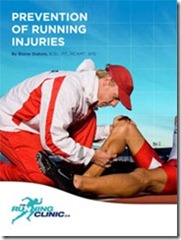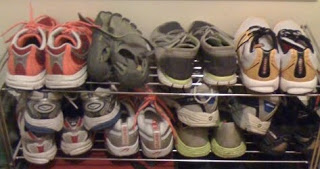
So here are my videos – they go in the following order – 1. stability shoe, 2. neutral racing shoe, 3. Vibram Fivefingers KSO, 4. barefoot:
Running in Asics Kayanos – Posterior View from Pete Larson on Vimeo.
Slow motion video of me running in Asics Kayanos, which are a high-end support/stability shoe. Looks like my feet are pronating quite a bit after footstrike despite the supposed stability features of the shoe (particularly pronounced on the left foot). Video shot at 300 frames-per-second with a Casio Exilim EX-F1 camera. Courtesy of runblogger.com/.
Running in Nike Lunaracers – Posterior View from Pete Larson on Vimeo.
Slow motion video of me running in Nike Lunaracers, which are a neutral, lightweight racing shoe. Looks like my feet are pronating quite a bit after footstrike. Video shot at 300 frames-per-second with a Casio Exilim EX-F1 camera. Courtesy of https://runblogger.com/.
Running in Vibram Fivefingers – Posterior View from Pete Larson on Vimeo.
Slow motion video of me running in Vibram Fivefingers, which are a barefoot-like, lightweight, non-supportive shoe. Looks like my feet are pronating quite a bit after footstrike – more pronounced on left side. Video shot at 300 frames-per-second with a Casio Exilim EX-F1 camera. Courtesy of https://runblogger.com/.
Running Barefoot – Posterior View from Pete Larson on Vimeo.
Slow motion video of me running barefoot on a treadmill. Looks like my feet are pronating quite a bit after footstrike. Video shot at 300 frames-per-second with a Casio Exilim EX-F1 camera. Courtesy of https://runblogger.com/.
My interpretation of these videos is that I would probably be classified as an overpronator by anyone who does gait analysis on a regular basis (and so I was by the salesman at the local running store when I first started running regularly back in 2007). I also show striking asymmetry, with much more pronounced pronation on the left foot (I already knew this, and it’s confirmed by the wear patterns on my shoes). What’s surprising to me is that I don’t really see much of a difference among the videos in how much my feet pronate after hitting the ground – they roll inward in all of the them. Even in the stability shoes (Asics Kayanos), my feet still pronate to what seems like a similar degree as in the other shoes (or barefoot), they just do it inside the shoe. This makes me wonder what benefit stability shoes are actually providing – I’ll have to hit the scientific literature and check out what data we have on the topic.
I’ll finish by pointing out that despite my pronation issues, I’ve been wearing lightweight, neutral shoes and the Vibram Fivefingers almost exclusively since last May with no injuries, pains, or any other issues. I tend to think of pronation as a natural process, and am curious to get into the scientific literature a bit more and try to find data that actually links pronation to increased chance of injury. Unfortunately, a lot of that data is likely proprietary and held by shoe manufacturers, which is unfortunate since as an academic scientist I’m trained to think that if data isn’t openly published through peer-review, then it’s not of any value. I’ll be back to post more when I’m done with a bit of research.



















Excellent blog post!
I agree with your findings. It didn’t look like the stability shoes did much of anything in regards to pronation control.
If you read the scientific literature, this doesn’t surprise me at all. I went through it all for an article on my blog on running shoes a while back.In a study by Stacoff et al. (2001) and Butler et al. (2007) they found that stability shoes did not alter pronation.
The whole pronation control thing is complete crap in my opinion.
Steve,
I think were very much on the same page on this – I’m not convinced at all
that pronation is a problem – it certainly hasn’t been for me. I’ve been
doing quite fine in non-supportive, lightweight, neutral shoes. Thanks for
the comment!
Pete
If these findings are accurate and I believe they are, what does it say about the theory of needing to buy new running shoes every 300 miles or so whether their worn or not? (not that I don’t welcome an excuse to buy new running shoes!). If the elements of the show that are supposed to help really don’t, what does it matter if it is worn?
Randy,
I think the breakdown with mileage is mostly in the cushioning in the sole,
and not so much the elements that supposedly limit pronation (e.g., medial
posting and the like). I tend to not worry about shoe mileage myself, but
there are certainly times when I know it’s time for a new shoe – I wore
through to the air chamber in a pair of Nike’s once! That being said, if
you don’t believe cushioning is essential, then the 300 mile rule may be a
bit extreme. I know a guy who put over 1000 miles on a pair of Vibrams.
Pete
very interesting. I’ve been trying to work out what my footstrike is ever since I started running. At the moment, I’m thinking I’m fairly neutral but good in a way to see that it doesn’t seem to make much difference anyway in terms of shoe selection
You are heel striking in all of your videos. How does the pronation change if you move to a midfoot or forefoot strike? I am a little surprised by these results. In my own experience I have noticed a large increase in my pronation when I where shoes. Primarily I blame the heel lift, but I also have wondered if the overall fit has allowed (or caused) the shoes to twist a little.
These videos are 2 years old – before I paid any attention to my form and when I had just started playing with the Vibrams. To be honest, I don’t know how my pronation changes, but I’m not too concerned since I don’t think pronation is a very big deal anyway.